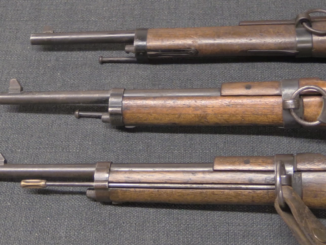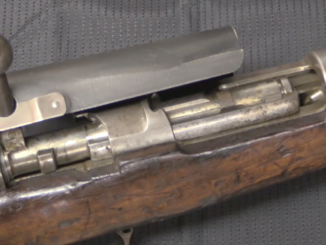With the MR-73 revolvers finally becoming regularly available in the US, I figured it would be really interesting to see how they are made! So, I headed over to Chapuis Armes, where the Directeur Général, Vincent Chapuis, gave me a really nice tour. Want to see? Let’s go in…
Related Articles

Manuals
Darne Mle 1923 Manual
In 1915, the French Darne company – best known for sporting shotguns – entered the military market with a contract to manufacture Lewis guns for the French Army. Apparently some of the folks at Darne […]

Bolt Action Rifles
The Berthier After World War One
In the aftermath of World War One, France would face the need to replace virtually all of its small arms, because nearly everything it had been using was either a wartime stopgap (like the Ruby, […]

Accessories
WW1 Rifle Mud Covers: Lebel & Gewehr 98
Given the prevalence of muddy horrible trenches in World War 1, why didn’t anybody design dust covers to protect the actions of their combat rifles? Well, they actually did… and today we are looking at […]

My Son turned me onto your work a few years ago. By far the best firearm source I know of!
Thanks Gun Jesus for everything you do.
Oh yeah, FIRST!
Just saw the video n YT and do not mind to be the first (?) to comment.
This is IMO the top notch presentation on part of both Ian (his engineering background shows) and Mr. Chapuis and his staff. I was really taken off my feet by seeing traditional hand tools. It reminded me my apprenticeship.
This is really as conventional production (part of manual touches) as it gets; nothing to hide or discover here.
Can you show more of the final polishing of the frames? Was it all by la macchina (machines)? Grazie!
Right, how the polishing is done; is it electro-chemically of by metal brushing? I suspect the latter.
Thanks for the video…
Raw hammer seems as made of investment casted rather than forged… The push pin traces can be seen there…
In a hand crafted revolver, is expected hearing only one “click” as trigger catching both the double action sear and revolving rachet at once… It is very important at rapid follow up shots… It can be checked by dry firing the gun in double action mode first… Releasing the trigger very slowly as hearing only one “Click” and pulling the trigger again without further release… If only the cylnder revolves without hammer strike or if the hammer strikes without tle cylinder rotatiom… Hand crafting is trash…. IMHO…
Are you saying this is a trash revolver? The shooters in the GIGN would seem to disagree with you.
Any revolver failing in the mentioned test and said being of hand crafted… Is trash… Do not know if this sample being one of them because no test applied… We all learn should anybody would dare to…
Trash Revolver. So what is the name of your manufacturing company? The MR-73 is an overpriced revolver when it comes to firing a .38/.357 round accurately down range. Any firearm which functions in that respect reliably is not trash. Cheap ‘Ruby’ .38 revolvers were cheap in the 1960s but seemed to shoot .38 bullets adequately. Same with early Rossi pistols. Cheap, not necessarily trash.
Any of my statement in my post pointing out this revolver as a trash… What said is, if a revolver being of “Hand crafted”, it should pass this very simple test… Try and see… Imagine an exited one at risky position having to fire a very expensive revolver in rapid follow up shots… Pulling the trigger and having only a cylinder rotation or only a hammer strike instead of an expected discharge… Who can give an extra time to save that life… What is the thing at holding hand… An expensive life saver or a trash…
Anybody can make this test with another well made or cheap revolver… Whatever the price is, the winner should be the revolver to be depended on…
Strongarm, you are not correct. If cylinder lock and hammer are slightly out of alignment, the worst thing to happen is that you could rotate the cylinder without firing, by very carefully pulling the trigger and releasing before firing. This is a non issue.
Mel… Thanks for your interest… What I mentioned is a reality… Once we all tested most of common well known brands and saw that if a well made revolver had passed the test, another of the same brand had failed… Only old Belgium made Nagants had passed with all samples… The distance between the two motion is so small and when fired, the recoil may give enough time for correction… But if the revolver has only a few cartridges and cylnder was shut without aligning the live round with barrel, an exited, afraid hand in hurry would miss to fire the cartridge as rapidly pulling the trigger as giving no enough time for both motion as simply rotating the cylinder without hammer impact or, only giving a stroke over the empty chamber without cylinder rotation…
If you have a revolver, please do this experiment… Unload the gun… Pull the trigger and release slowly by aid of your other hand… Hear only one “Click” and stop trigger release and… Pull the trigger again…
Set of pictures including internals
https://www.ar15.com/forums/Handguns/Another-Show-Stopper-Manurhin-MR73-Perfection-/33-197468/
Thanks. It works like a S&W Revolver! The old Webley works like a Colt (pre MK III Trooper type Colts).
Yes, except there are some small differences – take a peek here:
https://larvatus.livejournal.com/342060.html
Of course there are nuances, but in principle their lockwork works similarly. If you understand a S&W, you understand the Manurhin.
excellent video. great change from the usual excellent videos on the channel. if there is footage from the polishing and blueing, please show them!
Drool factor: high
Lust factor: high
Savings factor: nil
Oh well, maybe someday
Great video Ian, factory tours are always fun. How does posting it on youtube not violate the no gun making rule they had a while ago that your CETME build and WWSD 2020 receiver injection molding got caught up in?
The more there are rubbing surfaces in the mechanism, and the more numerous and stronger are the springs that press these surfaces. The worse the trigger characteristics are, and the more difficult this mechanism is in debugging and the more capricious in operation.
This is a problem with most modern revolvers (and not only).
There are too many “unnecessary” parts. Which (formally) are designed to ensure the safety and reliability of the operation, but in reality they only complicate the production and increase the price of the product.
The “old school” revolvers had decent triggers at a reasonable price because they did not have all these advertising-advanced safes against it is not clear what.
For a revolver, only one safe is needed, from a shot without pressing the trigger (for example, when falling).
Everything else is a fraudulent enticement of consumer money.